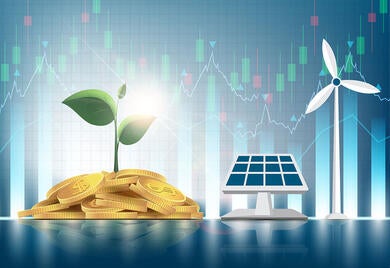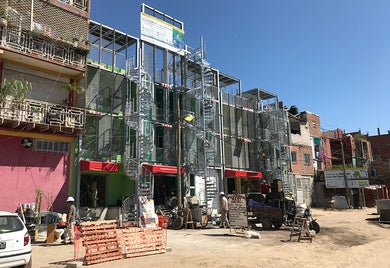
Sahara Dust Storms in the Caribbean, a Hazard For Both Humans and Coral Reefs
Saharan dust plumes are ramping up over the Caribbean region, creating health hazards that are particularly dangerous for those with their health compromised by COVID-19 or other problems. This is clear evidence that the region is not isolated from the effects of climate change elsewhere.

Transparency is good for business
One out of three Latin Americans acknowledges having paid at least one bribe in exchange for some type of benefit related to public services. In tandem with this, major corruption scandals have come to light in recent years, affecting both governments and private companies. Small and large-scale corruption and lack of transparency are present at the individual, government, and business level and adversely impact countries’ productivity and economic growth.

Sustainable Finance: What can the financial sector do to better manage environmental and social risks?
In January 2018, Larry Fink, the CEO of BlackRock published an open letter to the CEOs of publicly traded companies. His message was clear, companies have a responsibility to deliver profit, and make “a positive contribution to society.” Failure to do the latter comes at the risk of losing its license to operate. Consumers can influence through decisions to purchase products from companies that value broader corporate goals of environmental impact, workforce diversity, and community engagement. What may come as a surprise statement from a private equity fund with $6 trillion under management is increasingly the de facto market standard.

How we incentivize social inclusion through Sustainable Infrastructure? The case of Villa 31
Recently I visited the Villa 31 in Buenos Aires, Argentina. It is a poor and informal neighborhood located at approximately 500 meters from La Recoleta, one of the most sophisticated areas of the Argentinian capital. Despite this proximity, near 45,000 residents at Villa 31 have lived in isolation, not accepted as true “porteños” by their neighbors due to the social and economic characteristic of their community. My hope is that a new development project of sustainable infrastructure in the area changes this scenario. During my visit, I met fantastic people, but I experienced a strong mix of feelings. 20 years ago, I worked on an urban rehabilitation project in Brazil, which provided new homes, electricity, water, and sanitation to hundreds of low income people. By the end of the project, high-level dignitaries from the Government and other entities visited the new homes. One of them approached a woman benefited by the project and asked: “Are you happy? Is your life better?” She looked at him and said: “No, I am much worse off today. Before the project, I lived in a shack, I had no light, no water, no job, but no bills either. Now I have been given this nice house with bills to pay, but I still do not have a job. I do not know what to do”. 20 years after, I still carry this experience with me, even though we have learned a lot about urban development and inclusion projects ever since. The number of success stories has been growing, but its nature remains rather complex and represents a significant challenge to governments, policy makers, and financiers alike. According to an Inter-American Development Bank report: “Poverty-targeted projects that did not include specific objectives to reach excluded populations often reinforced their exclusion”. We must avoid this at all cost and work on the inclusion since the beginning. From Villa 31 to Villa “Thirty and Everyone” Working on sustainable infrastructure is not only about building new houses, but to improve the entire ecosystem around them to mobilize more human and economic resources that help people to break the poverty cycle. Villa 31 is not an isolated case. In Latin American and the Caribbean cities, informal areas can concentrate up to 50% of its habitants, and according the estimates, these number will keep rising. Development processes must include habitants’ perspective. Local communities have a voice, and the fact that we are listening to them makes a huge difference in terms of long-term acceptance, appropriation and viability. During my days at the Villa, I saw the construction taking place and the physical infrastructure being implemented. The work on water, sanitation, accessible roads, energy and electrified systems at Villa 31 is allowing its inclusion into Buenos Aires. More importantly, I saw people smiling and the pride on their eyes not only for the new structures, but for having a voice and being really included. So much that the initiative has been called Treinta y Todos (“Thirty and Everyone”) by Horacio Rodríguez Larreta, Buenos Aires city Mayor. This project has renewed people’s belief that their children would have the opportunity to live a different and better life, which is an essential success factor in such complex situation. Walking the talk at the Villa The feeling when leaving Villa 31 was completely different to what I felt 20 years ago, after our conversation with that woman in Brazil. I saw a high sense of trust and hope, so high that residents are already investing their own capital on improving their homes and establishing new business, such as: restaurants or beauty shops. Complementary initiatives like these are key, considering near 70% of the urban population of Latin America and the Caribbean works in the services sector, according UN-Habitat. A new socio-economic dynamic is developing, and some important external factors are fueling the process forward. The decision to establish a major government office building from the Education Ministry at the Villa provides a strong signal. However, it is not the only one. At the Inter-American Development Bank Group (IDB Group) we firmly believe in ‘walking the talk’, and the construction of the new Argentinian representation in Villa 31 shows it. This is a bold sign of commitment to the country and, more importantly, to the people. As part of the IDB Group, IDB Invest (formerly known as Inter-American Investment Corporation) is mobilizing resources and creating financial tools to stimulate private investments on these projects. Other public and private institutions should learn about the changes at the Villa, and hopefully decide to stand up and support this process too. [gallery type="slideshow" link="file" size="full" ids="7752,7753,7755,7757,7758,7759"] Subscribe to receive more content like this! [mc4wp_form]

Managing risks in an era of stakeholder capitalism
In 2020, firms will be judged less on how they respond to crises and more on how they anticipate them. Engaging stakeholders through technology is an important first step.

Can 'flotovoltaics' be a future partner for hydropower systems?
To address changing paradigms, a new technology has been proposed: hydropower plants that enable solar generation or hybrid hydro-solar systems.